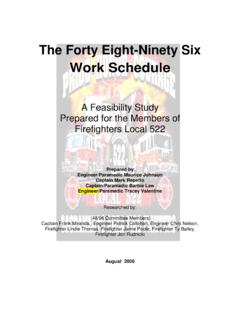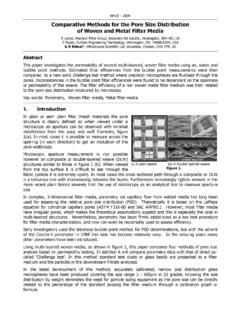Transcription of 24/48 VS. 48/96 WORK SCHEDULES: A COMPARATIVE …
1 Two Portland Fish Pier, Suite 209, Portland, ME 04101-4633 Tel: (207) 828-5151 Fax: (207) 828-5156 Website: Email: 24/48 VS. 48/96 work SCHEDULES: A COMPARATIVE analysis Susan L. Koen, President/CEO Round-The-Clock Systems Note: Dr. Koen is an organizational psychologist and globally-recognized expert on the topics of shift schedule design, safety & performance in 24-hour workplaces, and lifestyle strategies for shift personnel to achieve personal health and well-being. -1- 2005, Round-The-Clock Systems 24/48 VS. 48/96 work SCHEDULES: A COMPARATIVE analysis Over the last 10 years, there has been an increased drive to improve offtime patterns among shift employees in all types of North American industries. This drive has surfaced in U. S. fire departments as well, with the rapidly-expanding adoption of 48/96 work schedules.
2 The 48/96 schedule consists of two consecutive 24-hour shifts on duty, followed by four consecutive offdays (or four 24-hour shifts off duty). While there are many obvious benefits to any shift schedule that increases consecutive offtime, the true nature of any shift system both advantages and disadvantages can only be determined in a COMPARATIVE analysis . This document reviews the advantages and disadvantages of the 48/96 schedule in comparison to the 24/48 schedule , where a firefighter has one 24-hour shift on duty that is followed by two consecutive offdays. The key question to be answered here is this: does the benefit of more consecutive offdays provided by the 48/96 schedule create any negative costs in safety, health, on-duty performance, family distress or individual morale and job satisfaction? KEY WORKPLACE CONCERNS: FATIGUE & SLEEP DEPRIVATION The analysis of any shift schedule must begin with an assessment of the schedule s impact on firefighters alertness and fatigue levels.
3 Numerous safety studies have documented that a root-cause factor in human fatigue is the pattern of work and rest in the preceding seven-day period. For this reason, it is important to examine the work :rest ratio of a shift schedule . A minimum of a 3:4 ratio is needed to ensure that shift employees obtain a sufficient amount of rest and sleep in order to prevent cumulative physical fatigue as well as a sleep debt. The 24/48 schedule as well as the 48/96 schedule both have a 1:2 ratio, which is significantly better than the recommended minimum. Therefore, the structural design of both schedules supports employees needed sleep and rest cycles. A second factor to consider, however, is the frequency of sleep disruptions in an average night on duty. Sleep deprivation, defined as insufficient deep sleep or restorative sleep for the brain, causes cognitive or brain fatigue that can result in slowed reaction time, decreased vigilance and impairment in complex reasoning skills.
4 Firefighters who experience one call during their nighttime sleep period ( , between 10:00 6:00 ) typically will complete their first 24-hour workday in a state of mild sleep deprivation, depending on their ease of returning to -2- 2005, Round-The-Clock Systems sleep and their total sleep length that night. With a 5-hour block of restful sleep and at least one 90-minute completion sleep, sleep deprivation can be avoided. Those firefighters who average two calls during a typical on-duty night will most likely be in a state of moderate sleep deprivation, where cognitive fatigue problems will begin surfacing. Having a second 24-hour on-duty day, without any opportunity for on-shift napping or restorative sleep, could put those firefighters at risk for some safety and performance challenges. If sufficient restorative sleep is obtained, however, a 48/96 schedule can be utilized without high risk.
5 Firefighters at busy, mostly large-city stations that average three or more call-outs per on-duty night are likely to be severely sleep deprived at the end of their 24-hour workday. These stations should not consider a second consecutive 24-hour shift, as required in the 48/96 design. FAMILY CONCERNS: QUALITY OFFTIME Research on family distress among shiftworking households, including firefighters, have revealed that the offtime pattern of the shift employees work schedule is the most significant determinant of family well-being. In other words, is the firefighter at home and positively interacting with his/her spouse, children and other family members often enough and for long-enough duration to be a viable family member? There are four key aspects of offtime schedules to consider. The first is the amount of consecutive hours available to be a fully-present, active family member.
6 In the 24/48 schedule , many firefighters report that they have only one evening out of every three to interact with their family members, free of worries about preparing for the next on-duty day. By comparison, the 48/96 schedule provides three evenings out of each 6-day schedule cycle when the firefighter can attend to his/her family unencumbered by work concerns. Two other offtime factors are the amount and frequency of weekend offtime afforded by the work schedule . With so many North Americans living in dual-earner households, where the non-shiftworking spouse most often has a weekday, day-shift job, weekends increasingly have become prime time for families. In this regard, numerous surveys have shown that family members prefer full weekends off as compared to split weekends where either Saturday or Sunday are scheduled offdays but not both. Full weekends typically enable families to travel away for recreation or visits with nearby family or friends, without children having to miss school or the spouse having to miss work .
7 In comparing the 24/48 and 48/96 schedules on weekend offtime patterns, there is no doubt that the 48/96 schedule provides better quality weekends for firefighters and their families. First, with respect to Friday-night offtime patterns, firefighters on the 48/96 schedule work two Friday nights and then have four consecutive Friday -3- 2005, Round-The-Clock Systems nights off. This Friday-night offtime pattern enables shift employees to engage with their children s school sports teams, most of whom play on Friday nights, for more consecutive weeks than does the 24/48 schedule . This opportunity is particularly valuable at the end of each sports season when post-season championship games are played in succession. As to Saturday and Sunday, the 48/96 schedule requires firefighters to work one full weekend out of every six (17%). However, this missed weekend is surrounded on either side by five consecutive weeks where the firefighter has one or both weekend days as off-duty days.
8 Moreover, the trade-off benefit in this schedule is that 50% of the weekends or three consecutive weekends out of every six are full 2+-day weekends off. Contrasted with the one 2-day weekend off out of every three (33%) provided by the 24/48 schedule , there clearly is more weekend family time available on the 48/96 schedule . The last offtime factor to consider is the consecutive time spent away from spouse and children. There is no doubt that a 48-hour on-duty assignment results in more consecutive time away from family members than a 24-hour on-duty assignment. In those families where there is high dependency on the firefighter for security, care and/or maintenance needs, the longer time away from the family will create heightened distress for both the family and the firefighter. In families where the non-shiftworking spouse functions with more independence, the consecutive offtime afforded by the 48/96 schedule will be viewed as more beneficial and valuable to the family unit, offsetting the negative feature of greater consecutive work time.
9 Thus, the importance of this consecutive work time will vary based on internal family dynamics. CONCLUSIONS This COMPARATIVE analysis has focused upon those features of the 24/48 and 48/96 work schedules that are known to cause challenges or bring positive benefits at work and at home. From this analysis , it is clear that the two schedules are the same in their overall work :rest ratio. The 24/48 schedule requires less consecutive time away from one s spouse and children, although the overall ratio of time at work and time at home are identical for these two schedules. Where the 48/96 schedule gains a more positive edge over the 24/48 schedule is in its offtime pattern. Specifically, the 48/96 schedule enables firefighters to be with their families for enough consecutive days to feel fully engaged in their home life. Being at home both days of the weekend, for half of the weekends of the year, adds further to this opportunity to be a vital, participative family member.
10 -4- 2005, Round-The-Clock Systems The one caution concerning the 48/96 work schedule , as compared to the 24/48 schedule , concerns the degree of sleep deprivation that firefighters are likely to have at the end of each 24-hour on-duty period. Those who are called out an average of once per night should have no trouble working a 48-hour assignment, especially if they are knowledgeable about how to return to good-quality sleep after their call. Those firefighters who receive an average of two calls per night would benefit from knowledge about split-sleep strategies and from time in their second on-duty day for a restorative (30-minute) nap or full (90-minute) completion sleep. Importantly, knowledge about effective sleep strategies can be obtained through shiftwork education courses, such as the widely-used Shiftwork: How To Cope Programs (see ). Lastly, fire companies or truck units that have three or more calls per night, resulting in insufficient deep, restorative sleep for the brain to function effectively will be too sleep deprived to be safe and effective in their second 24-hour on-duty day.










